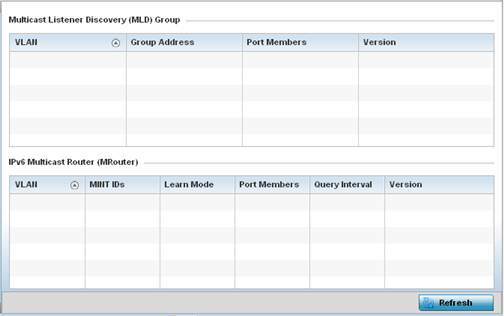AP Network MLD
MLD snooping enables a controller, service platform or Access
Point to examine MLD packets and make forwarding decisions based on content. MLD is
used by IPv6 devices to discover devices wanting to receive multicast packets
destined for specific multicast addresses. MLD uses multicast listener queries and
multicast listener reports to identify which multicast addresses have listeners and
join multicast groups.
MLD snooping caps the flooding of IPv6 multicast traffic on
controller, service platform or Access Point VLANs. When enabled, MLD messages are
examined between hosts and multicast routers and to discern which hosts are
receiving multicast group traffic. The controller, service platform or Access Point
then forwards multicast traffic only to those interfaces connected to interested
receivers instead of flooding traffic to all interfaces.
To view network MLD statistics:
-
Select the Statistics menu from the Web
UI.
-
Expand the System node from the
navigation pane (on the left-hand side of the screen).
The System node expands to display the RF
Domains created within the managed network.
-
Expand an RF Domain node, and select
one of it's connected access points.
The Access Point's statistics menu
displays in the right-hand side of the screen, with the Health tab selected by
default.
-
Expand the Network menu from the
left-hand side of the UI.
-
Select MLD.
The stats is displayed in the right-hand pane.
The
Multicast Listener Discovery (MLD) Group field describes the
following:
| VLAN |
Displays the group VLAN where
the MLD groups multicast transmission is
conducted. |
| Group
Address |
Displays the Multicast Group
ID supporting the statistics displayed. This group ID is
the multicast address hosts are listening to. |
| Port
Members |
Displays the ports on which
MLD multicast clients have been discovered. For example,
ge1, radio1, etc. Ports can vary somewhat amongst
supported controller and service platform
models. |
| Version |
Displays each listed group‘s
version compatibility as either version 1, 2 or
3. |
|
The
IPv6 Multicast Router (MRouter)
field describes the following:
| VLAN |
Displays the group VLAN where
the multicast transmission is conducted. |
| MINT
IDs |
Lists MiNT IDs for each listed
VLAN. MiNT provides the means to secure communications
at the transport layer. Using MiNT, a controller or
service platform can be configured to only communicate
with other authorized (MiNT enabled) devices. |
| Learn
Mode |
Displays the learning mode
used by the router as either Static
or PIM-DVMRP. |
| Port
Members |
Displays the physical ports on
which multicast clients have been discovered by the
multicast router. For example, ge1, radio1, etc. Ports
can vary somewhat amongst supported controller and
service platform models. |
| Query
Interval |
Lists the query interval
implemented when the querier functionality is enabled.
The default value is 60 seconds. |
| Version |
Lists the multicast router
version compatibility as either version 1, 2 or 3. The
default setting is 3. |
|
-
Select Refresh to
update the screen's statistics counters to their latest values.
